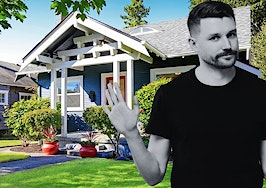With fewer deals to go around, many markets experiencing a downshift and more agents than ever, it makes business sense to reach for the fundamentals. That’s why at Inman, we’re going Back to Basics with curated throwbacks to some of our most-read stories as well as new insights from agents in the field — all culminating in Inman’s Playbook for the Fall Market, a two-day virtual event that you should make plans to attend.
Are you receiving our weekly Teams Beat newsletter? For the latest news, insight and trends on teams, subscribe here.
Shortly after purchasing a historic mansion built in 1928 that needed some “updating,” one of our new neighbors, introducing themselves, asked, “Have you seen the movie, ‘The Money Pit’?” It was a foreshadowing of things to come.
When an email featuring our current home hit my inbox, both my wife and I instantly knew it was the home for us. We have always loved historic homes and the irrefutable charm you do not see in modern homes. While we have happily lived in newer homes in classic suburbia, we have always enjoyed meandering through historic, tree-lined neighborhoods and viewing classic styling that differs house-by-house.
Older homes have a sense of scale and craftmanship that is almost impossible to emulate in today’s cookie-cutter world. Duplicating the intricate millwork and architectural details has grown too expensive, and modern designs have all but eliminated exquisite detailing. Along with this, it is almost impossible to find craftsmen who know how to duplicate or repair historical features.
As someone who is a licensed general contractor and has owned a few historic homes, I have had a bit of experience with older properties, both good and bad. Depending on the region you live in, “historic” can have a different connotation.
On the east coast, homes can be hundreds of years old and were built without any interior plumbing or electrical. On the west coast, it is very rare to see a residence constructed prior to 1880 and most were built with some internal plumbing and newly emerging electrical technology.
Here is a list of 14 things to take into consideration when eyeing historical homes:
1. Foundation
Homes built to current building codes have engineered concrete foundations with extensive rebar and, in some cases, post-tensioning. While concrete has been around since Roman times, older homes here in the U.S. can have a number of types of foundations including stone, brick, concrete and even plain dirt.
The type of soil under the home also makes a tremendous difference, with some types of soil requiring additional underpinning to ensure the foundation does not move over time.
New homes also have extensive anchoring systems that connect the home to the foundation. Older homes do not. In some cases, there may be a few anchor bolts placed a distance apart, but in other situations, there is no actual mechanical connection between the foundation and the home unless extensive seismic upgrades have been performed.
If a person has trouble with their feet, it dramatically affects the rest of their body. It is the same with a house — foundation problems affect everything above and can be extremely costly to repair. Compounding the issue, some older foundations have little or no rebar and, depending on the mix, can have grown quite brittle over time.
If you encounter a home with significantly sloping floors, cracks in the walls, doors and windows that do not open or close properly, the foundation may be in trouble. In this case, we recommend an extensive foundation inspection to see whether or not repairs are practical.
While older homes frequently have cracks in their foundations, some can be catastrophic while others are merely cosmetic.
2. Electrical
As late as 1925, approximately 50 percent of homes in the U.S. still did not have electricity. Prior to electricity, homes depended on gas for lighting.
As electricity began being rolled out, the primary focus was lighting. Since there were still only a limited number of applications and devices that used electricity, the number of outlets throughout the home was limited, with many rooms only having one outlet.
This is a problem for modern residents: Our demands for electricity are dramatically higher and current codes require that no outlet be further than six feet away from any location on a wall. While many rooms only require one outlet per wall, longer walls require an outlet no further part than twelve feet. The process of adding additional electrical outlets and lights to a historic home can be a daunting task.
The second issue in older homes is the type of wiring used. Knob and tube wiring was the standard for early electrical installations and it had two inherent problems: The gauge of the wiring was not always consistent and the protective insulating cover on the wire is known to grow brittle and deteriorate. These two issues combine to produce conditions that can lead to a fire.
First, if the wiring is overloaded and the fuse or breaker is not properly rated, the wire can overheat. As the external coating frays, that heat can easily ignite combustible materials located in too close a proximity.
For this reason, many insurance companies are reluctant to insure homes with knob and tube wiring and it is recommended that insulation not come in contact with the wiring. This can cause huge issues when trying to effectively insulate an older home.
Lastly, since lath and plaster cover the walls, the process of opening the walls to upgrade the electrical can be daunting.
Many older homes came with electrical panels designed to handle loads of 30 to 50 amps. Today, due to increased electrical requirements, homes are typically being built with distribution panels rated for 150-200 amps. Upgrading an older home to modern standards includes running a higher service to the home (which can be quite expensive, including new trenching or overhead wiring), a larger main distribution panel, new internal wiring, GFCI and arc fault circuit breakers, and more.
In many cases, older electrical panels were in closets and other inaccessible locations. Modern codes will require the relocation of the main panel to a more suitable location. It goes without saying that this can be an expensive process.
3. Plumbing
As plumbing began transitioning inside, it did so with materials available at the time. Supply lines were either lead or galvanized pipe and waste lines were frequently cast iron with custom connectors or pipes made of lead. Lead pipes used to supply drinking water can cause significant health issues, which were not properly understood at the time.
New supply line installations now use copper, PVC variants or PEX. While cast iron is still occasionally used in waste lines, the go-to product has become ABS pipe with some connectors made of brass or PVC.
Older homes that have lead pipes should have them removed or at least abandoned in place. Cast iron waste lines should be examined to ensure they do not have corrosion which could lead to a breach. Galvanized pipes tend to deteriorate internally over time with the result of dramatically slowing the flow of water. When possible, these should be upgraded.
Older fixtures such as tubs may not fit today’s practices and may need to be removed. Those old tubs are typically cast iron, weigh a ton and were installed before the walls were finished. Removing them is often a matter of breaking them apart in place and then removing the pieces. This is a job best left to an experienced plumber.
Modern plumbing fixtures are also designed with water conservation in mind, and, although the older fixtures may have nostalgic value, it might not be wise to keep them. In some cases, finding parts to maintain older plumbing fixtures can be a real challenge.
4. Lath and plaster
Prior to the advent of convenient drywall, homes had lath nailed to the walls (rough sawn boards typically a couple of inches wide and ¼” thick) that were spaced approximately ¼” apart. Plaster was then applied to the walls and held in place by the lath. The binding material used to make the plaster adhere to the walls often contained horse hair.
Plaster had a few advantages, including the ability to easily handle curves and contours. It is also more fire resistant and can provide some sound dampening. The downsides, however, can be daunting.
Whereas it is easy to cut a hole in drywall to access the interior of the wall to run electrical, cutting holes in plaster walls and then repatching is a significant pain.
Older homes also settle, and when they do, the stress causes cracks in the plaster. Repairing these cracks can require extensive and expensive work, made even more difficult by the fact that workmen with extensive knowledge of lath and plaster are a dying breed.
Hanging pictures can be difficult since pounding a nail into a lath and plaster wall can cause cracks. Frequently, older homes have a picture rail near the ceiling from which pictures would be suspended by wire.
Replacing lath and plaster in an entire home is done by demolishing the existing wall coverings and replacing with drywall. This can be cost-prohibitive and, in some cases, homeowners simply cover them with ¼” sheetrock.
5. Hazardous materials
Prior to modern medical knowledge, homes were built with materials we now know to cause health issues. Asbestos, found in shingles, flooring, ceiling coverings, heating ducts, exhaust flues and more, was used because of its remarkable heat resistance and binding capabilities. Lead is most frequently found in pipes and paint. It can be cost prohibitive to completely remove either product from a home.
With the exception of lead pipes, encapsulation is often used to prevent harm to the occupants. Special care must be provided during any renovations since the chance of lead dust or asbestos particulates getting released is significant.
6. Insulation
Many old homes have no insulation. While some may have had insulation added to the attic in the past, walls are notoriously void. Over the years I’ve encountered homes where various methods have been employed for insulation, including sawdust, vermiculite, shredded newspaper and more.
Insulating the walls can be tricky, especially if the home has stucco, stone or brick on the exterior coupled with lath and plaster on the interior.
7. Heating
Our current home, in addition to three wood-burning fireplaces, began its life with a coal furnace (we still have the coal chute) and was then upgraded at some point to heating oil. Heating a multi-story house the size of ours with a single furnace in the basement required that the furnace be massive: We nicknamed it “Behemoth.”
While the heating fuel of preference varies across the country, most homes in our area are heated with natural gas. In our case, the property had never had a connection to natural gas, but since we wanted to upgrade our heating, add a gas cooking range, BBQ, hot water heater and convert our fireplaces from wood to gas, we had to negotiate with the local gas utility to get a connection.
In some cases, this can be quite expensive. A second option is to go with propane and have a tank installed, if local codes permit.
8. Millwork
One of the hallmarks of older homes is the beautiful millwork. Unfortunately, the cost to replicate or even repair damaged millwork can be extensive if there is a desire to keep everything historically accurate. In my case, since I am qualified as a custom millworker and have an extensive shop, I can handle this myself.
Even then, I had a local shop custom fabricate 1,000 feet of casing to match the existing millwork so we could trim out new doors and windows. Understandably, this is not an option for most and finding personnel to do quality work at a reasonable price can be extremely difficult. Additionally, the standardized materials sold in most lumberyards do not match older trim, which typically varies dramatically from home to home.
9. Roofing
Older homes frequently have complicated rooflines and our home is no exception, complete with a 14/12 roof pitch, multiple dormers, an eyebrow roof over the main entry, a turret and three balconies over the living areas. Since the cost of a new roof can be exorbitant, older homes often come with roofs that have been maintained in a patchwork fashion instead of being replaced. Be prepared to replace the roof at some point.
The last consideration here has to do with the type of roof: Some materials used in the past are longer allowed in certain regions across the country (e.g. wood shingles or shakes). Some companies, attempting to find suitable replacements for wood roofs, developed products that failed after a short period of time with accompanying lawsuits and bankruptcy. In these cases, repair is not an option.
As mentioned later in this article, historic associations may also have very specific guidelines as to what materials may or may not be used. If, as an example, the home has a slate roof needing extensive repair, associations may dictate that the reroof looks identical, even though modern slate-looking replacement products could cost substantially less. We recommend an extensive roof inspection by a licensed roofing contractor.
10. Windows and doors
Windows on historic homes are old. They are single pane, come with missing sash weights, broken hardware, rotten frames and, in many cases, are painted shut. They transmit weather almost as if they were not there and can leak profusely.
If you decide you want to upgrade to new, dual-pane windows, you will quickly discover that the cost of replacing the existing look can be very expensive, both for the windows themselves and the installation. If you want to simply replace them with standard vinyl windows, much of the historic look will disappear and you will still have to order them totally custom as old windows never came in standard sizes.
A lot of careful planning should go into replacing the windows if you want to maintain the current look.
11. Hardware
I have owned my existing home for over a year and am still looking for replacement hardware. As an example, all my doors have mortice locks in various states of repair made by manufacturers that went out of business years ago. There are a few companies that supply some replacement hardware, such as House of Antique Hardware and Historic House Parts, but getting an exact match is very difficult.
Oh, and did I mention that the replacement hardware is typically very expensive? Coupled with the fact that interior doors may be damaged or covered with decades of paint, some owners choose to get all new doors and hardware that has a “historic” look to it with modern functionality at a fraction of the cost.
Light fixtures also fall into this category: While they may look cool, some old light fixtures may be missing parts that are impossible to replace. Additionally, the finish may have deteriorated over the years or they may have been painted a ridiculous color by someone back in the 70’s.
If you plan on upgrading the light fixtures, you may discover that it is not as easy as you might have imagined. Some older lights have wider bases than existing light fixtures and are frequently connected to wires that simply poke through the ceiling with no electrical box.
You may damage the plaster while trying to bring things up to code, which then involves more work patching along with painting. It can be a classic case of being up to your armpits in alligators when all you wanted to do is drain the swamp.
12. Rot, decay and pests
It goes without saying that a property that has been haphazardly maintained by a varied assortment of people with varying levels of attentiveness will probably have some decay. Homes built decades ago did not have access to the modern weatherproofing materials we have today and, consequently, leaks are inevitable.
Once water penetrates a structure, it is only a matter of time until rot settles in. If the rot is easily accessible, such as the exterior trim around a window, it can easily be replaced. If water has seeped deeper into a wall, however, extensive repairs may be required, especially if the rot has compromised structural components of the home, such as support beams.
Frequently, the extent of decay will not be apparent until the walls are opened up. At this point, once the damage is revealed, you will need to trace it until you reach solid wood and then rebuild as required. It can be a very expensive process if the rot goes deep.
Pests are also an issue, with varying types of wood-destroying insects such as termites, carpenter ants, wood-boring beetles, bees, wasps and so on. We have discovered walls with comprehensive beehives, large wasp nests, beams that have been significantly compromised by termites and more. We recommend wood-destroying pest inspections to determine whether or not there is any damage that will need to be addressed. In our area, inspectors also look for fungus and dry rot.
Rodents are also a concern. They not only cause a health risk because of their continuous defecation, but they chew on wires inside walls, damage pipes, tunnel through insulation and more. Left on their own over a long period of time, the infestations can be horrific.
We have also encountered raccoons in attics and it is not unusual to find a carcass of some kind in crawl spaces or other recesses. If there is visible evidence of rodents, we recommend an inspection be performed by a licensed pest abatement company. As with rot, the extent of damage might not be visible until walls are actually opened.
13. Room configurations
Older homes typically have smaller bedrooms with tiny closets, harkening back to a time when wardrobes were limited and children were not allowed to sequester themselves in their rooms with video games. You could count on a separate parlor and traditional dining room, along with other classic features.
Newer homes have different configurations and to live in an older home, you have to be able to adapt to the historical room configurations or plan on doing some extensive renovations.
14. Historical registry, districts, neighborhoods and preservation societies
This last consideration may in fact be the most important. Make sure you check to see if the home you are interested in is on the national or state registry of historic homes. If it is, you may be significantly limited in what you can do to upgrade the property.
Your home might not be registered as historic, but it might be in a historic neighborhood or preservation society that also has very strict rules that govern what you can or cannot do. I have seen situations where officials in these various entities have made life very difficult for the new owners.
There is a lot to be said for buying a historic property. You are, literally, buying a piece of history. We have had a lot of fun tracking down information on previous owners, along with pictures and more. Our home is actually mentioned in a book based in our area.
Historic homes are also in mature neighborhoods: Our previous historic home was in a neighborhood lined with oak trees that spanned the streets providing a lush, verdant canopy through which the sun, streaming through the leaves, danced on the street below.
Buying such a home, however, is a classic case of “Buyer beware.” There is much more involved than meets the eye and the accompanying risk is greater, to be sure. On the other side of the coin, however, people are enraptured when they visit our current home, complete with classic architectural details and built-ins, amazing rooms and stunning views.
It is a one-of-a-kind property and the rewards of living here far outweigh the benefits of any home we have lived in previously. We carefully examined everything and counted the cost before we bought and, although there have been some surprises, we have been delighted with our purchase.
Carl Medford is CEO of The Medford Team.













